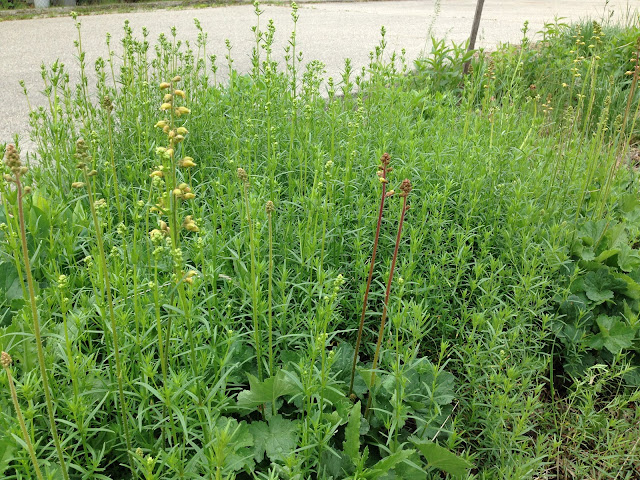On almost the last day of May, we had just under two inches of rain (the yellow line above). That has brought our precipitation up to the levels of 1886 (black line) which was a drought year. Prior to the rain, soil in the Produce Garden where last winter's leaf mulch had blown away pored like sand through our fingers. However, where our leaf mulch stayed in place, the soil underneath the leaves had a vague amount of moisture. With the end of month rain, our soil is in great shape.
The rain has been good for the beds in the Kitchen Garden and Produce Garden. We anticipate that the rain washing into the two native gardens will really help with the growth and flowering of our native plants. Last year was the sleep-creep-LEAP year for our native plants planted in 2015. We anticipate that there will be more native plant leaping in 2018.
Temperature-wise, we are somewhat warmer than 1886:
You can see all of the May charts in the Weather folder.
Riel House Posts
Riel House Pages
Saturday, 2 June 2018
Observations 2018: 27 May - 3 June
We are being rewarded for our work and patience over the last several years.
Soil
In 2015, we created raised beds in the Kitchen Garden and Produce Garden. That meant defined paths in between beds upon which we no longer walked and compressed the soil. We have added approximately thirty yards of aged cow manure into the gardens; we have mulched with six hundred bags of leaves. Last fall, we laid down thirty bales of wheat straw into the paths. Here is our dark and friable result:
Native Plants
In 2015, we replaced a dismal dandelion-infested strip of grass in the centre of the parking lot with a full suite of randomly planted native plants. Although there are still some dandelions - and we recently spent at least one full day weeding them - the native plants are beginning to grow together and crowd out the invasives:
Soil
In 2015, we created raised beds in the Kitchen Garden and Produce Garden. That meant defined paths in between beds upon which we no longer walked and compressed the soil. We have added approximately thirty yards of aged cow manure into the gardens; we have mulched with six hundred bags of leaves. Last fall, we laid down thirty bales of wheat straw into the paths. Here is our dark and friable result:
 |
| Dark soil and worms |
 |
| Last year's leaves mulching the Kitchen Garden |
Native Plants
In 2015, we replaced a dismal dandelion-infested strip of grass in the centre of the parking lot with a full suite of randomly planted native plants. Although there are still some dandelions - and we recently spent at least one full day weeding them - the native plants are beginning to grow together and crowd out the invasives:
 |
| Goldenrod and Three Flowered Avens Coming Together - less room for weeds |
 |
| Dense canopy of native plants - remaining dandelions just off camera to the right |
Dark Soil; Lots of Worms
When planting tomatoes on Friday, we encountered many worms during our digging. This year, the soil is dark, friable and full of worms. It is easy to plant. It has been easy to weed. After three years of adding leaves, compost, and most importantly, refraining from severe digging and turning over the soil, we are having soil success.
Here are some more soil pictures:
 |
| A shovelful of soil and earthworms |
 |
| Dark soil underneath last winter's mulch |
Monday, 28 May 2018
Check Out Our Photo Gallery
Don't forget to check out our latest photographs in our Photo Gallery. All our photographs starting in 2014 are stored there. Also check out the captions in the information area. Typically, the older photographs have more captions.
Potatoes and a Bulb Planter
 |
| Strange Bedfellows |
Here's how we do this using square foot gardening.
Lay the grid on the four foot wide bed. Position the sixteen potatoes; one per square foot. Flip the grid for the next sixteen potatoes to be positioned. Keep going like this until all the potatoes for the bed have been positioned. Meanwhile, the two planters, one on each side of the bed plant the eight potatoes in front of them, then move to the next eight potatoes. And of course move, then replace, the mulch as you plant. Because of our mulch, today's soil was slightly damp and full off earthworms despite the hot weather and only one inch (25 millimeters) of rain since the beginning of April.
The person positioning the potatoes will have just enough time to finish the bed, halve and position the potatoes for the next bed before the planters are ready to move to that bed. We planted seven 4 x 22 foot beds in just over an hour. Only three more beds to go.
With this method, we planted a fifty pound sack of Russet Burbank potatoes for every five 4 x 22 foot beds. And, as an FYI, each 4 x 22 foot bed takes 44 potatoes split into two; 88 halves in 88 square feet.
Subscribe to:
Comments (Atom)




